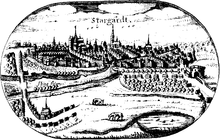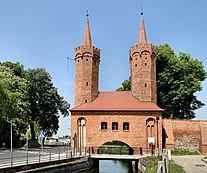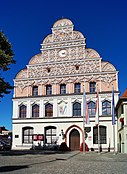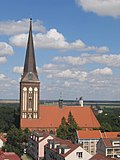|
Stargard
Stargard ([ˈstarɡart] ⓘ; 1945: Starogród, 1950–2016: Stargard Szczeciński; German: Stargard in Pommern or Stargard an der Ihna; Kashubian: Stôrgard) is a city in northwestern Poland, located in the West Pomeranian Voivodeship. In 2021 it was inhabited by 67,293 people.[1] It is situated on the Ina River. The city is the seat of the Stargard County, and, extraterritorially, of the municipality of Stargard. It is the second biggest city of Szczecin agglomeration. Stargard is a major railroad junction, where the southwards connection from Szczecin splits into two directions: towards Poznań and Gdańsk. EtymologyThe city's name is of Pomeranian (Kashubian) origin and stands for old (stari) town/city (gard or gôrd).[2] In this meaning, the term gard is still being used by the only surviving Pomeranian language speakers, the Kashubs. However, some experts say that the name is of proto-Norse origin: starn (star) and gate (as in English).[3] HistoryMiddle Ages The settlement was founded in the 8th century at the site of the present-day district of Osetno near downtown Stargard.[4] In 967 it became part of the emerging Polish state under the first Polish rulers from the Piast dynasty.[4][5] Stargard was first mentioned in 1124,[6] when it was part of Poland under Bolesław III Wrymouth. A church was founded in 1140.[7] Stargard received Magdeburg city rights in 1243 from Barnim I, Duke of Pomerania. It was one of the most important towns and a major trade centre of the Duchy of Pomerania, after it split off from Poland as a result of the 12th-century fragmentation of Poland. From 1283, the city had a port at the mouth of the Ina River in the nowadays abandoned village of Inoujście.[6] Defensive city walls were built in the 13th century and expanded in the 14th, 15th and early 16th centuries.[8] In 1363 the city joined the Hanseatic League. As a result of the ongoing fragmentation of Pomerania, in 1368 Stargard became part of the Duchy of Słupsk (Pomerania-Stolp) and in 1377 it became the capital of a separate eponymous duchy, which in 1403 fell back to Duchy of Słupsk, a vassal state of the Kingdom of Poland. In 1478 Stargard became part of the reunified Duchy of Pomerania. In the meantime, the trade rivalry with the nearby city of Szczecin led to the outbreak of the Stargard-Szczecin war in 1454,[6] which ended in 1464. In 1477 Stargard helped Duke Wartislaw X recapture the town of Gartz during a Brandenburgian invasion.[9] Modern period Stargard was part of the Duchy of Pomerania until its dissolution after the death of the last duke Bogislaw XIV in 1637.[6] During the Thirty Years' War the city was captured by Sweden in 1630.[8] It was besieged by the troops of the Holy Roman Empire in 1635,[10] and in order to hamper the attacks the Swedish commander set fire to the suburbs, causing a city fire, however, it was still captured by imperial troops.[11] In 1636 it was recaptured by the Swedes, then it was taken and plundered by Imperial troops to fall back to the Swedes again after the Battle of Wittstock.[12] In 1637 it was again captured by Imperial troops and then by Sweden.[12] As a result of the war, the population decreased by about 75%.[13] In accordance to the 1648 Peace of Westphalia, in 1653 it was incorporated, together with the rest of Farther Pomerania, into Brandenburg-Prussia.[6] In 1701 Stargard became part of the Kingdom of Prussia and in 1818, after the Napoleonic Wars, Stargard became part of the new district Szadzko (then officially Saatzig) within the Province of Pomerania. During the Franco-Prussian War (1870–1871), the Prussians established a prisoner-of-war camp for French troops in the city.[14] As a result of the unification of Germany in 1871 the city became part of the German Empire. On 1 April 1901 it became an independent city, separate from the Saatzig District. According to the Prussian census of 1905, Stargard had a population of 26,907, of which 97% were Germans and 3% were Poles.[15] During World War I, the Germans operated a prisoner-of-war camp in Stargard, which housed in total some 50,000 POWs, including Russian (including ethnic Poles from the Russian Partition of Poland conscripted to the Tsarist army), French (including Algerians), Belgian, American, English, Serbian, Romanian, Portuguese, Italian and Japanese.[16] In interwar Germany, the town was the site of a concentration camp for unwanted Jewish immigrants from Eastern Europe.[17] The Stargarder Zeitung was as a local newspaper published in Stargard. In the March 1933 German federal election the Nazi Party received 58.7% of the vote in the city.[18] World War II In 1939, during the German invasion of Poland, which started World War II, the Germans established the Dulag L temporary camp for Polish (including Kashubian) prisoners of war and civilians near Stargard, which in October 1939 was transformed into the large prisoner-of-war camp Stalag II-D.[19] Then, after the battle of France in 1940, also the French, the Dutch and Belgians were held there, from 1941 also Yugoslavian and Soviet POWs, from 1942 also thousands of Canadians captured at Dieppe, one of whom was Gerald MacIntosh Johnston, a Canadian actor, who was killed trying to escape, and after 1943 also Italians. The POWs were subjected to racial segregation, and Poles, Africans, Arabs, Jews and Soviet troops were separated from POWs of other nationalities and subjected to worse treatment.[20] Serbs also faced more severe treatment.[21] There were also two subcamps of the Ravensbrück concentration camp, one in Stargard and one in the present-day district of Kluczewo,[22] as well as seven forced labour camps.[6] The Polish resistance organized a district of the Union of Armed Struggle and Home Army in Stargard, under the cryptonym "Starka".[23] Polish underground press was distributed in the city.[24] In February 1945, one of the last German armoured offensives, Operation Solstice, was launched from the Stargard area. The local population was evacuated by the Germans on the order of Heinrich Himmler before the approaching Soviets in the final stages of the war.[13][4] As a result of World War II the town again became part of Poland, under territorial changes demanded by the Soviet Union at the Potsdam Conference. Polish local administration was appointed on March 23, 1945.[13] The town was repopulated by Poles, many of whom were displaced from former eastern Poland annexed by the Soviet Union. Post-war periodIn 1950 the city was renamed Stargard Szczeciński by adding the adjective Szczeciński after the nearby city of Szczecin to distinguish it from Starogard Gdański in Gdańsk Pomerania.[13] In 1961 the city limits were expanded by including the settlement of Kluczewo as a new district.[6] In 1979 the city suffered a flood. In 1993 the city celebrated the 750th anniversary of receiving city rights.[13] In 2004 a north-western part of the town was made into an industrial park - Stargardzki Park Przemysłowy. Another industrial park is located in the south - Park Przemysłowy Wysokich Technologii. On January 1, 2016, the town was renamed back to Stargard.[25] Landmarks and monumentsSights of Stargard Renaissance Town Hall A Gothic townhouse, today a music school Arsenal Medieval town walls with the Pyrzycka Gate St. John's Church Wałowa Gate War cemetery Heavy bombing during World War II devastated most of Stargard's fine historical sites and destroyed over 75% of the city. Some of these monuments, such as St. Mary's Church (13th–15th centuries) and the 16th-century town hall, have been rebuilt.[26] The newly restored buildings are on the European Route of Brick Gothic. Some of the notable surviving examples include:
Other sites include:
Sport The city is home to Spójnia Stargard, a men's basketball team, which competes in the Polish Basketball League (the country's top division), 1997 runners-up, and Błękitni Stargard, formerly a multi-sports club, now a men's association football team, best known for reaching the Polish Cup semi-final in 2015. Demographics  
Notable people
International relationsTwin towns — sister citiesIn fictionIn The Cross Time Engineer science fiction series of novels the main character falsely claims Stargard origin to conceal he is a time traveler. NotesReferences
External linksWikimedia Commons has media related to Stargard Szczeciński. |
||||||||||||||||||||||||||||||||||||||||||||||||||||||||||||||||||||||||||||||||||||||||||||||||||||||||||||||||||||


















